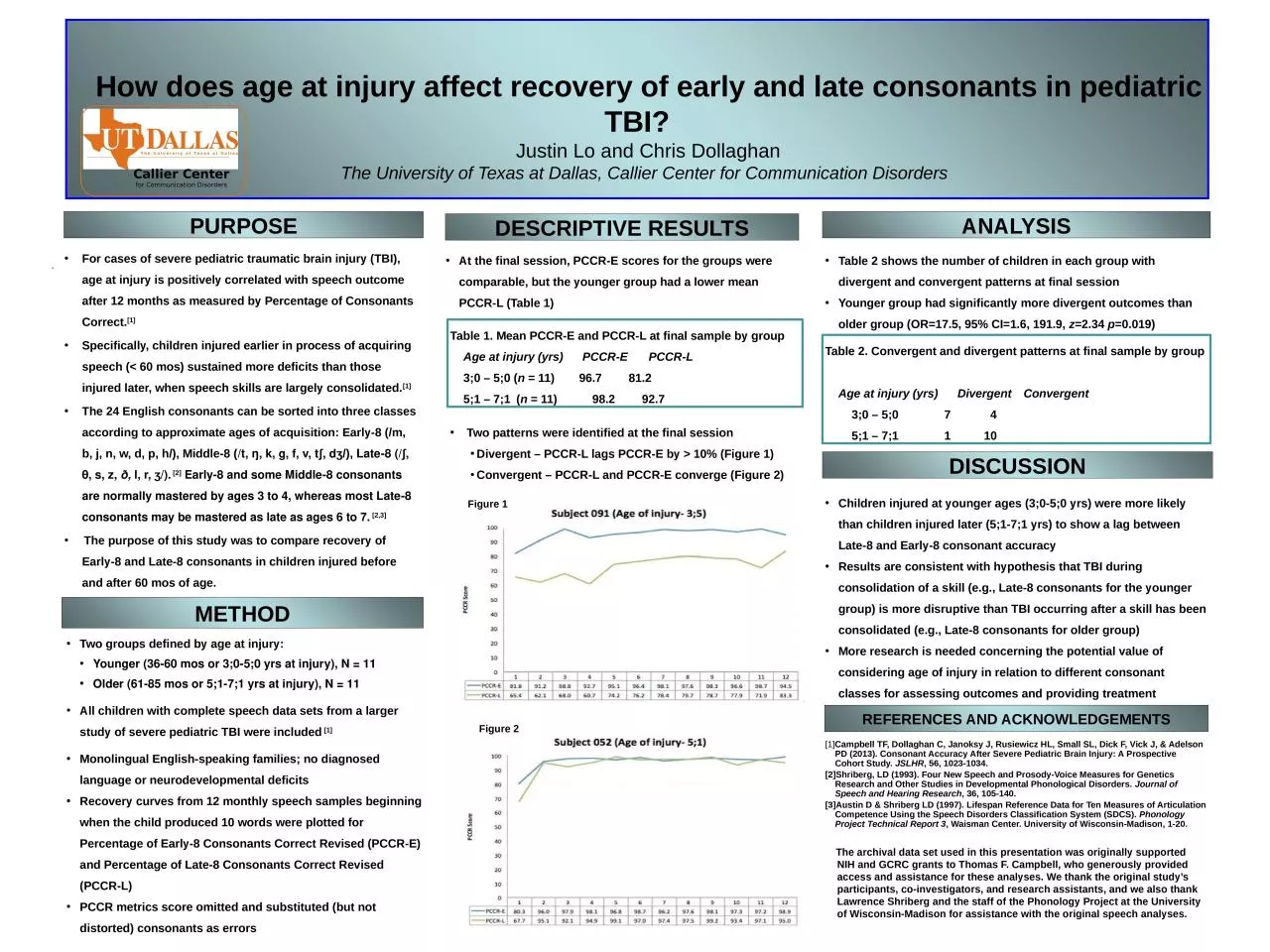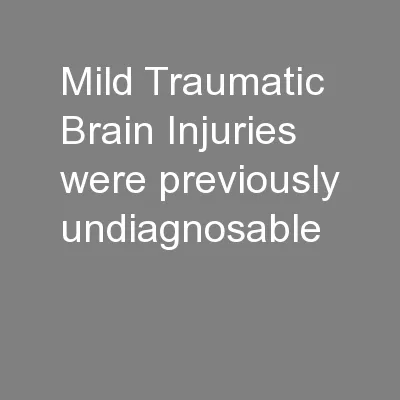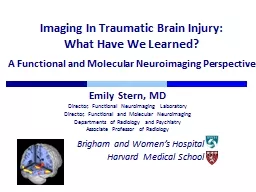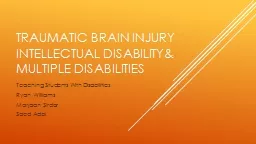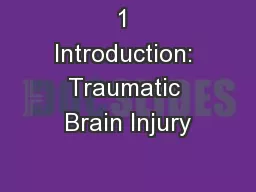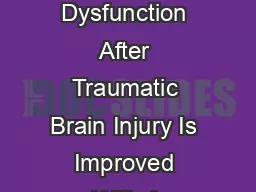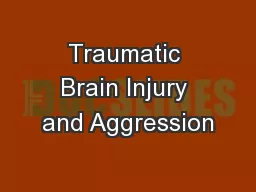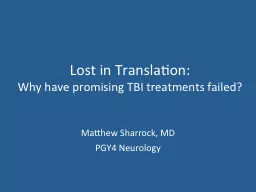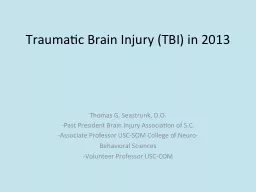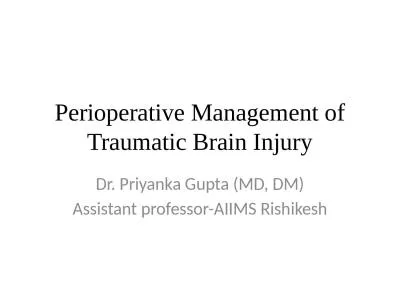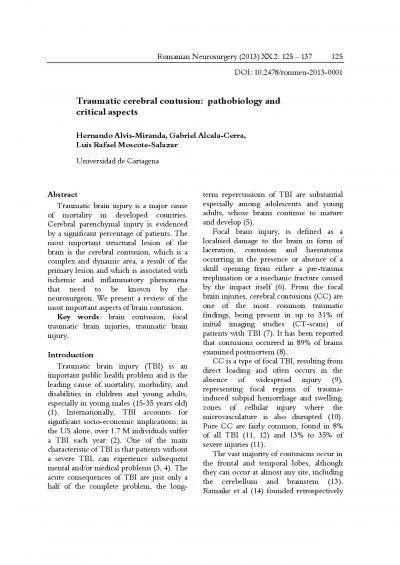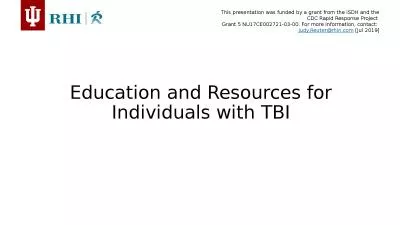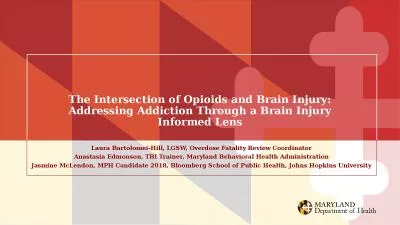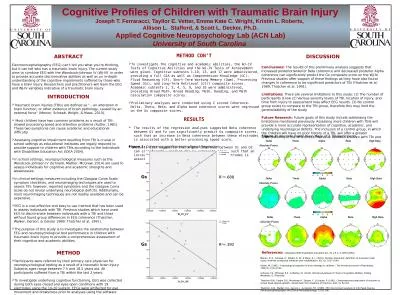PPT-For cases of severe pediatric traumatic brain injury (TBI), age at injury is positively
Author : singh | Published Date : 2023-06-10
1 Specifically children injured earlier in process of acquiring speech lt 60 mos sustained more deficits than those injured later when speech skills are largely
Presentation Embed Code
Download Presentation
Download Presentation The PPT/PDF document "For cases of severe pediatric traumatic ..." is the property of its rightful owner. Permission is granted to download and print the materials on this website for personal, non-commercial use only, and to display it on your personal computer provided you do not modify the materials and that you retain all copyright notices contained in the materials. By downloading content from our website, you accept the terms of this agreement.
For cases of severe pediatric traumatic brain injury (TBI), age at injury is positively: Transcript
1 Specifically children injured earlier in process of acquiring speech lt 60 mos sustained more deficits than those injured later when speech skills are largely consolidated 1 The 24 English consonants can be sorted into three classes according to approximate ages of acquisition Early8 m b j n w d p h Middle8 . Anne Felicia Ambrose, MD, MS. Medical Director, Traumatic Brain Injury Program. Mount Sinai School of Medicine. New York , NY. NY-TBI Model Systems. Case. 63 year old man. Accountant. Mild cognitive impairments 3 years ago following a cardiac stent. Kim Armenta DO, Universitiy of California, Irvine Medical Center, Irvine, CA; Bianca Tribuzio DO, University of California, Irvine Medical Center, Irvine, CA; Robert A. Bitonte MD JD, University of California, Irvine Medical Center, Irvine, CA; Julie K. Ho, Esq. Tustin, CA. What Have We Learned?. . A Functional and Molecular Neuroimaging Perspective. Emily Stern, . MD. Director, Functional Neuroimaging Laboratory. Director, Functional and Molecular Neuroimaging. Departments of Radiology and Psychiatry. intellectual disability& Multiple Disabilities . Teaching Students With Disabilities . Ryan Williams . Marjaan. . Sirdar. Saed. . Adbi. Traumatic Brain Injury. Often referred to as TBI. Traumatic brain injury (TBI) is a serious public health problem in the United States. Each year, traumatic brain injuries contribute to a substantial number of deaths and cases of permanent disability. In 2010 2.5 million TBIs occurred either as an isolated injury or along with other injuries.. Chris Rorden. Overview of course. Motivation and Significance of Topic. Basic terms and anatomy. 2. Brain function. Brain functions are both distributed and modular. . Modular: focal injury can lead to specific impairment. . Phosphodiesterase. 4B Inhibitor. Titus DJ, Wilson NM, Freund JE, . Carballosa. MM, . Sikah. KE, . Furones. C, Dietrich WD, Gurney ME, Atkins CM. 2016. Journal of Neuroscience 36(27):7095-7108. Patricia Olson, MS3, PhD. Hal S. Wortzel, MD. Director, MIRECC Neuropsychiatric Consultation Services and Psychiatric Fellowship. VISN 19 MIRECC, Denver Veterans Hospital. Assistant Professor of Psychiatry. Faculty - Neurobehavior Disorders Program and Division of Forensic Psychiatry. Matthew Sharrock, MD. PGY4 Neurology. Overview. Introduction. Diagnosis and Classification. Primary and Secondary Injury. Early . TBI . management. Experimental Data & Clinical . Trials. Future Directions. Thomas G. Seastrunk, D.O.. -Past President Brain Injury Association of S.C.. -Associate Professor USC-SOM College of . Neuro. -. Behavioral Sciences. -Volunteer Professor USC-COM. Some General Facts:. Dr. Priyanka Gupta (MD, DM). Assistant professor-AIIMS . Rishikesh. Introduction . . “a blow to head or a penetrating head injury that disrupts the function of brain”. One . lakh. lives are lost every year due to TBI in India. Traumatic cerebral contusion: pathobioHernando Alvis-Miranda, Gabriel Alcala-Cerra, Luis Rafael Moscote-SalazarUniversidad de Cartagena Traumatic brain injury is a major cause of mortality in develo Professionals Who Work . with . Individuals with Brain . I. njury. Professionals who work . with . individuals with brain injury:. . Clinical Neuropsychologist. A . Clinical Neuropsychologist . specializes in the clinical evaluation of brain functions and other psychological conditions for purposes of:. Laura . Bartolomei. -Hill, LGSW, Overdose Fatality Review Coordinator. Anastasia Edmonson, TBI Trainer, Maryland Behavioral Health Administration. Jasmine McLendon, MPH Candidate 2018, Bloomberg School of Public Health, Johns Hopkins University. Joseph T. Ferraracci, Tayllor E. Vetter, Emma Kate C. Wright, Kristin L. Roberts, . Allison L. Stafford, & Scott . L. Decker. , Ph.D.. Applied Cognitive Neuropsychology Lab (ACN Lab). University of South Carolina .
Download Document
Here is the link to download the presentation.
"For cases of severe pediatric traumatic brain injury (TBI), age at injury is positively"The content belongs to its owner. You may download and print it for personal use, without modification, and keep all copyright notices. By downloading, you agree to these terms.
Related Documents

